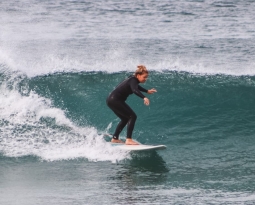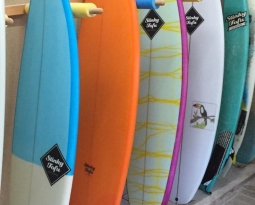Massages After Surfing: Recovery for the Body
Surfing is a demanding sport that challenges the entire body. The muscles are constantly engaged to maintain balance, perform quick movements, and interact with the waves. After an intense surf session, a massage can be an excellent way to relax the stressed muscles, relieve tension, and promote recovery. In this text, we’ll explore the muscles most affected by surfing, the benefits of a massage, the different types of massages, as well as additional recovery methods such as stretching, applying sport creams, and using a foam roller.
1. Muscles Most Affected by Surfing
Surfing primarily engages the muscles in the upper body, arms, core, and legs. During paddling and riding waves, the following muscle groups are heavily engaged:
-
Shoulder and Upper Arm Muscles: While paddling, the upper body—especially the shoulders—is put to work. Key muscles include the trapezius, deltoids, and the biceps.
-
Back Muscles: The latissimus dorsi and other back muscles are consistently activated in surfing to keep the body in position and assist with the wave movements.
-
Abdominal Muscles: The core muscles play a critical role in stabilizing the body, particularly during wave rides and fast body turns.
-
Leg Muscles: Thighs, calves, and glutes work constantly while maintaining balance on the board and executing quick movements.
-
Hip Flexors and Glutes: The hip flexors and glutes are highly engaged during the standing position on the surfboard.
2. Benefits of Massage After Surfing
Massages after surfing offer numerous benefits, particularly regarding muscle recovery and relieving tension:
-
Relieving Muscle Tension: After a surf session—especially an intense one—muscles can become tense. A massage helps to relax these muscles and release any tightness.
-
Improved Circulation: Massages promote blood circulation, which helps deliver nutrients and oxygen to the muscles while also aiding in the removal of metabolic waste products like lactic acid.
-
Pain Relief: Targeted massages can alleviate soreness caused by overuse or muscle imbalances during surfing.
-
Stress Relief: The physical relaxation from a massage has a positive effect on the nervous system, leading to an overall sense of well-being and relaxation.
-
Shortened Recovery Time: Regular massages can speed up recovery time between surf sessions, allowing the body to get back to full capacity more quickly.
3. Types of Massages in Sports and Relaxation
There are various massage techniques that can be applied after surfing, depending on the desired outcome:
-
Sports Massage: This technique focuses on loosening the muscles, releasing tension, and promoting recovery. It’s especially helpful after intense physical activity like surfing. Sports massages often use deeper and more forceful pressure techniques to effectively work through the muscles and release blocked areas.
-
Deep Tissue Massage: This technique targets the deeper muscle layers and connective tissue. It’s effective for addressing chronic tension and can be especially beneficial for surfers who put significant strain on their muscles.
-
Aromatherapy Massage: This relaxing massage combines gentle touch with the use of essential oils, which have a calming effect on both body and mind. It’s perfect for unwinding after a long surf day and reducing stress.
-
Trigger Point Massage: This massage focuses on “trigger points” where tension tends to build up in muscles. It helps to release specific pain spots and relieve muscle tightness.
-
Swedish Massage (Relaxation Massage): This gentle technique is designed to promote relaxation and overall well-being. It’s not as intense as a sports massage, but it’s effective in reducing stress and promoting recovery after surfing.
4. Additional Recovery Methods
In addition to massages, there are other effective methods that support recovery after surfing:
-
Stretching: Stretching the muscles that were most engaged during surfing is crucial for maintaining flexibility and preventing further muscle tightness. Focus on the shoulders, back, and legs to ease tension.
-
Sports Creams and Ointments: Using creams with cooling or warming properties can help relieve muscle soreness and promote healing. These products enhance circulation and are particularly useful for pain and tension following a surf session.
-
Foam Roller (Black Roll): A foam roller is a great tool for loosening up the muscles and breaking up fascial adhesions. Targeted rolling can relieve muscle tightness and accelerate recovery.
-
Warm Baths or Ice Baths: Soaking in a warm bath with essential oils or taking an ice bath can help relax the muscles and improve circulation. Alternating between hot and cold water (contrast baths) is particularly effective in promoting recovery.
Conclusion
A massage after surfing is an excellent way to relax the body, relieve muscle tension, and promote recovery. Along with massages, stretching, the use of sports creams, and foam rolling are effective additional measures to speed up recovery and prevent injuries. Surfers should make use of these recovery techniques to stay in peak condition and enjoy the sport for a long time.





